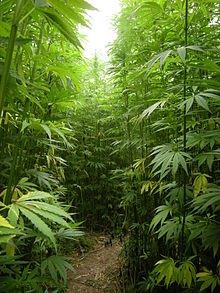On the Rope Walk
Cathy M Koos
My dad had this funny saying whenever we were wandering around the countryside – “We’re on the road to Hemp.” Usually muttered on that ubiquitous Sunday drive of the 60s, no one seems to know what this actually meant, just that we were possibly lost or simply taking the road less traveled.
Hemp production is now the road less traveled, but until the mid-20th century, it was definitely a highly valued, frequently cultivated crop worldwide. Post-war Europe and America then banned production. There is some conjecture that timber magnates in the early 20th century pressured Congress to ban hemp because it competed with timber for products like paper. And, of course, the drug related issues. Later development of synthetic fibers further doomed hemp production.
The 2018 US Farm Bill made industrial hemp legal once again and recognized it as an agricultural commodity. By 2019, 47 states legalized hemp cultivation in some form, but growing pains abound. While now vilified in some circles as a potential gateway drug, environmentally friendly hemp has been a priceless historic and prehistoric fiber.
Botanically, Cannabis sativa sativa is the industrial strain, and Cannabis sativa indica is the recreational species. The primary difference is the amount of the psychoactive component THC (tetrahydrocannabinol).
Contemporary Uses
In addition to textiles and rope, hemp is used as a clean-up crop to clear sewage and chemical spills, as well as clearing radioisotopes at the Chernobyl nuclear disaster site. Biodiesel is produced from oils in seeds and ethanol from fermented stalks. Car makers are mixing hemp with other bast fibers to create composite materials for dashboards. Hemp gives fine specialty paper, but production costs are high yet for everyday paper products. Building blocks for construction are proving promising for durable and eco-friendly products.
Prehistoric Times
Archaeologic evidence suggests hemp is one of the earliest cultivated plants, possibly as far back as 8000 BCE. Even in Neolithic times, according to textile expert Elizabeth Wayland Barber, Cannabis sativa was common across Europe and Asia, first for its ritualistic and recreational use, and much later as an exceptionally strong textile component.
For millennia, hemp was an important crop in Asia and the Middle East, and the Wampanoag people of Cape Cod were noted to be cultivating hemp in the early 1600s. Some American colonists made a distinction between Indian hemp and English hemp, with the former likely being the hallucinogenic strain. This indigenous Indian hemp species was Apocynum cannbinum. Some evidence is found pointing to American colonists imbibing on the THC qualities of hemp, but most were growing for textiles and rope.
Colonial Times
With the rise of the British navy, demand for hemp skyrocketed. Each sailing ship required 55 tons of fiber for rope and sails—that’s 30 miles of rope. Demand was so great that each British ship cast hemp seeds on most islands visited, so there would be a ready supply for replacement ropes. Colonists in America were also mandated to grow hemp for the king’s navy.
In addition to wool, flax and tobacco, George Washington advocated hemp as a cash crop for rope and fiber. In 1775 this promotion of colonial hemp cultivation increased exponentially once Britain began its pre-Revolution embargo known as the Prohibitory Act, cutting off the colonies from outside trade.
While flax was grown for finer linen textiles, hemp produced higher yields and a better product for ropes, sails, and sacks. Tents and uniforms for the new revolutionary army created demand, as well.
Hemp fabric for tents, sails and wagon covers were woven warp-faced, to improve rain run-off. The fibers would swell when wet, also making them impermeable, so long as no one touched the tent wall.
Cultivation
Hemp is very temperature tolerant and can germinate in the cooler temperatures of early spring. Compared to soil-depleting cotton and tobacco, deeply rooted hemp requires much less water, no pesticides, and thrives in poor soil. Grown closely together, this dense habit also reduces the amount of the drug-rich resin of unfertilized female flowers, and induces very tall plants with minimal branching, lengthening the fibers in the stalk.
Processing
Processing of hemp is similar to flax – cut or pulled stalks laid out in swathes to dry, and then either dew- or water-retted. Once dried, the stalks are scutched, decorticated and separated into bast fiber, hurd, and green microfiber, and then spun into yarn.
The Rope Walk
Rope of any type has been made the same way for millennia. For shorter lengths of rope needed in a hurry, fibers were likely spun off the thigh. Once greater lengths were needed, the rope walk was invented. The oldest rope walk still in use is in Kent, England. A narrow, covered shed a quarter of a mile long, the rope walk can produce over 700-foot lengths of rope. Many bobbins of yarn were set into racks and yarn was run the length of the rope walk. The yarn ends were hooked together, and a device called a “top” moved down the walk while a machine twisted each strand. Multiple strands are laid on each other, reversing the twist with each pass, strengthening the rope.
The Future
If we can get around some of the cultural issues, the future of hemp cultivation looks promising. Beer, vodka, clothing, milk, soap, sunscreen, medical products, and even toilet tissue, so we can save our trees for something more than a royal flush.
Attribution ShareAlike 3.0
Photo Olivier DUPORT – Atelier du Chanvre, CC BY-SA 3.0,
